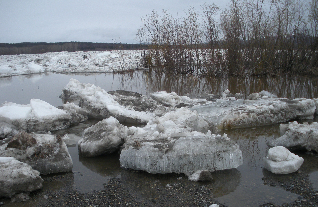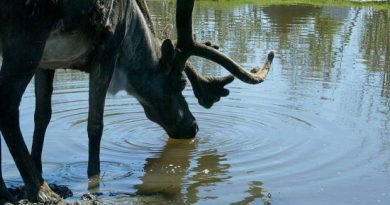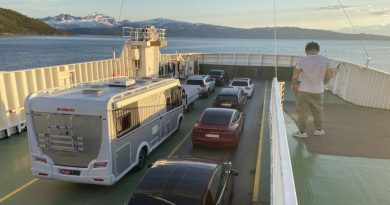Flooding threat wanes across Alaska
 Outsized fears of flooding prompted by winter’s epic snowfall across much of Alaska have given way to relief in many of the state’s riverside villages: A cold spring has helped ice and snow melt gracefully.
Outsized fears of flooding prompted by winter’s epic snowfall across much of Alaska have given way to relief in many of the state’s riverside villages: A cold spring has helped ice and snow melt gracefully.
But river forecasters and villagers remain worried about two major areas in Western Alaska — the lower Yukon and Kuskokwim rivers — where river ice remains thick.
Villagers in Lower Kalskag on the Kuskokwim River said they were braced for rising back-flow because ice slabs seemed to be jamming up downriver.
“Everyone will probably stay up all night,” watching the ice-jumbled river alongside the village, ready to evacuate in boats, said Vivian Changsak, the environmental coordinator and vice president of the tribal council in the village.
Easy so far
Will the final days sabotage what has been a calm breakup season, an official at the National Weather Service’s River Forecast Center in Anchorage wondered.
Two experts from the center, paired with state emergency officials, have flown sections of Alaska’s two longest rivers as the breakup front crashes toward the Bering Sea. Reports have been positive.
“Things have proceeded fairly easily so far,” said Jim Coe, a river-forecast hydrologist.
Break-up is a spring ritual in Alaska as river ice moves downstream and snow melts from mountains. Rarely is it this easy. Ice slabs and floodwaters roared into Crooked Creek last year and in Eagle in 2009, ripping homes and buildings from foundations.
This year, slow thawing has allowed side channels to melt open in several places, including near Circle on the Yukon. That’s taken pressure off the river’s still-frozen main stem by providing alternative routes for surging ice and water, Coe said.
“Instead of a big push of water that comes up 10 feet, the big push this year is 3 or 4 feet,” he said.
Chilly evenings help
The view wasn’t so rosy a month ago. A winter of heavy snow and sub-zero cold produced thick river ice and deep snowpack. Villagers worried that prolonged cold followed by sudden heat could be a formula for disaster. Risks were so high that US Sen. Lisa Murkowski organized a public roundtable to hear from state and federal emergency officials about preparations.
But fortunately, most of the state hasn’t seen much spring warmth. Temperatures along some of the Kuskokwim River were still falling below zero at night recently, said Andrea Gusty, a spokeswoman for Murkowski. But warming in the day allowed steady melting, allowing the river ice over time to get “nice and slushy,” so it can break apart easily.
On Monday, the forecast center had no flood watches across the state. The lone flood warning was for Aniak on the Kuskokwim River.
The village of about 500 experienced “very minor” flooding during the day, including over some roads and at one end of the runway near the river. The ice had bottled up about 10 miles downstream, Coe said.
The light flooding prompted workers at the tribal hall to leave early for the day because the office is on the flood-prone side of town, said Nicholas Morgan, a custodian at the building who lives nearby. Some residents worried about getting trapped on that side of town if waters rose too high, he said.
Just a week ago, Aniak residents were concerned, he said. During winter, temperatures had plunged into the minus-40s for days at a time as the river ice thickened. Meanwhile, snow piled up.
What about Bethel?
But by Monday afternoon, the ice jam downriver had apparently broken because the light flooding in Aniak seemed to have plateaued, he said.
“I’m thinking this will be the peak of it,” he said. “That’s my hope.”
That could spell trouble for residents downriver in Lower Kalskag, who were eyeing the river warily, said Changsak.
“Water slowly coming up bank-to-bank” and big chunks of ice aren’t moving, she said Monday afternoon, describing the view from her window at the tribal office.
Earlier in the day, flowing water crested the road in some spots and was several inches high near the high school and fuel tanks. Residents in the village of 300 had their small boats near their houses, just in case.
“We have a plan,” she said. “If it gets too much water we’ll get to the elementary school because it’s one of the higher points.”
As the ice continues moving down the Kuskokwim, it could still cause trouble around the hub city of Bethel, population 6,200, where the Kuskokwim River ice is still 40 inches thick.
“The big concern is down in Bethel,” Coe said.
But it could be days before forecasters have a better idea how things will play out there, he said.
“Of all the things we forecast, breakup is probably one of least accurate, because it depends so much on what happens with the weather,” he said.
Contact Alex DeMarban at alex(at)alaskadispatch.com
For more stories from Alaska Dispatch, click here




I had a fascinating read! Thank you so much for that. Would you mind if I add your article to my web directory about boating. It would be a pleasure for me.